Jury unable to reach verdict; mistrial declared
Published 11:13 am Tuesday, October 17, 2017
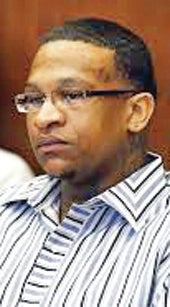
- Tellis
Jury unable to reach verdict; mistrial declared
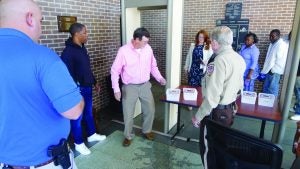
Security was tight at the Panola County Courthouse as spectators, news media and members of the victim’s and defendant’s family such as Jessica Chambers’ father Ben Chambers (in pink shirt) were all sent through metal detectors strategically placed for a secure courtroom. Officers of the Batesville Police Department assisted Panola County Sheriff’s Department with security during the much publicized trial.
The Panolian Photo by John Howell
By John Howell
After a six-day trial and nine hours of deliberation, and after several confusing attempts to declare their decision to Judge Gerald Chatham Monday afternoon, the jury in the Quinton Tellis murder trial was unable to agree on a verdict. The judge thanked the jury, who were chosen in Pike County and transported to Batesville last Sunday. Then he declared a mistrial.
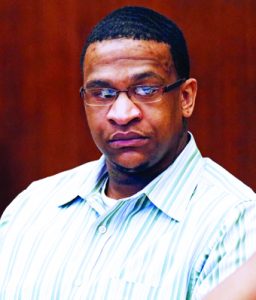
Tellis
Day 1
More than 100 Pike County residents showed up at the courthouse in Magnolia Monday, October 9, at 9 a.m. responding to subpoenas for jury service.
By 3:30 p.m., 15 jurors — 12 with three alternates — had been selected. Circuit Judge Gerald Chatham, after giving jurors preliminary instructions telling the jurors what they might expect, told them to go home, pack and return to the courthouse by 5 p.m. ready to travel to Batesville.
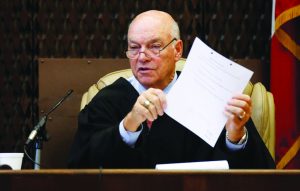
Circuit Judge Gerald Chatham instructs the jury on the paperwork that must be filled out when they reach the verdict in the capital murder trial of Quinton Tellis, 29, charged with burning 19-year-old Jessica Chambers, to death almost three years ago, in his Batesville, Miss., courtroom, Sunday, Oct. 15, 2017. Chambers was on fire when she was discovered, next to her burning car along a back road in Courtland, Miss., Dec. 6, 2014. Tellis has pleaded not guilty to murder. (AP Photo/Rogelio V. Solis, POOL)
“We’re going to work on Saturday,” Judge Chatham said. “I’m going to get you back down here as quick as I can.”
And work on Saturday they did — from 9 a.m. until 7 p.m. during the trial’s fifth day October 14, then again on Sunday, starting at 1 p.m. with attorneys’ closing arguments that ended about 4 p.m. when the decision was turned over to the jurors.
Tuesday, Day 2
Opening arguments came after the trial began at 2 p.m. Tuesday — the afternoon hour to allow jurors to be rested after their late-night arrival at the Batesville motel where they would spend the next seven nights.
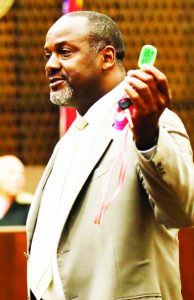
Defense attorney Alton Peterson
In his opening statements to the jury District Attorney John Champion asked them not to make a determination on the name “Eric” until they had heard all the testimony concerning the December 6, 2014 crime.
“Evidence will show Eric is not on trial here,” defense attorney Darla Palmer told jurors.
It was a theme that would be carried throughout the trial with the prosecution carefully building its case to convince jurors that possible suspects with the name “Eric” were systematically and painstakingly eliminated before investigators eventually returned to Tellis as a suspect. Palmer and co-counsel Alton Peterson just as doggedly kept hammering that Chamber’s naming “Eric” was a dying declaration that should have excluded their client Quinton Tellis from culpability.
Tuesday afternoon testimony by then-Courtland Fire Chief Cole Haley brought the courtroom to tears as he recounted how he tried to comfort the badly burned acquaintance whom he did not recognize when he found her so badly burned that Saturday night almost three years ago.
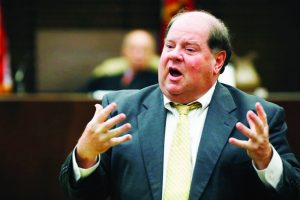
DA John Champion makes his closing statement.
AP Photos/Rogelio V. Solis
“Have you ever seen anything like that in your life,” DA Champion asked Haley.
“No sir and I hope I never see anything like it again,” he responded.
Haley is no longer a firefighter and stated he had suffered with problems since, “knowing that people out there can be that cruel.”
Palmer and Peterson hammered first responders on their written occurrence reports where they stated the victim had named “Eric” as her assailant.
One of the 15 jurors was removed from the mixed jury for having violated Judge Chatham’s rules about social media contact, leaving seven blacks and five whites, six male and six female. The two alternates would remain throughout the trial until the judge released them prior to deliberations that would begin Saturday night.
Jurors also heard from Chambers’ close friend Kesha Myers and her mother, Lisa Chambers Daugherty.
Wednesday, Day 3
Champion and assistant District Attorney Jay Hale continued to build their case chronologically. Their witnesses include Panola County Sheriff Dept. Lt. Edward Dickson, the initial law enforcement officer on the scene that night and Sheriff Dept. Major and head investigator Barry Thompson. Dickson’s testimony about the area of the crime scene and evidence collected was scrutinized during skeptical questioning by Palmer and Peterson who asked why the scene was not expanded to the area across Herron Road from which the burned victim came walking when Courtland firefighters first reached the scene.
Thompson described the groundwork and the exponential expansion of the investigation as the heinous nature of the crime drew national attention. He described the conference room at the David M. Bryan Justice Complex as a “war room” where agents from multiple local, state and federal law enforcement agencies exchanged information and assigned responsibilities.
During Wednesday afternoon testimony, prosecutors showed a large aerial photo of the Courtland area while Thompson pointed to stops that jurors would make on Thursday during a field trip to review the crime scene and significant locations cited in the state’s case against Tellis.
By the end of Wednesday, 18 witnesses had testified.
Thursday, Day 4
Jurors visited the Panola County jail and saw Chambers’ burned 2004 Kia where it had been moved for evidence collection, M and M Grocery at Courtland, Tellis’ home across Highway 51 from M and M Grocery, the driveways into the Tellis home and the area next door and the location on Herron Road where Chambers and her burning car were discovered.
When jurors and court officials returned to the courtroom Thursday afternoon, jurors heard testimony from Dr. William Hickerson, director of the burn unit at Memphis Regional Medical Center who said that Chambers had no chance of survival when she arrived.
During questioning from prosecutors, Hickerson testified that injuries to her mouth and airway were sufficient to impair normal speech. Hickerson was among several afternoon witnesses, including Dr. Erin Barnhart, Mississippi’s deputy chief medical examiner in 2014. Barnhart said the autopsy determined that Chambers suffered second and third degree burns over most of her body except the groin, buttocks and bottoms of her feet, areas, he said, that were probably protected by Chambers having been in a sitting position when she was doused with gasoline.
Thompson was also called back and questioned further about the investigation.
Friday, Day 5
The prosecution’s case against Tellis took a high-tech turn, first with testimony from Mississippi Bureau of Investigation Agent Tim Douglas, who had been MBI’s supervisor of the state’s northern district in Dec. 2014.
Douglas described the intensity of the investigation during its early stages that included himself and Major Thompson interviewing Tellis a few days after the murder where he said that he was not with Chambers after noon on the day she was killed.
After months of investigating tips, Jessica’s phone contacts and Facebook friends, “It was all turning into dead ends,” Douglas said.
Authorities decided to re-interview Tellis in November, 2015, after Paul Rowlett, an intelligence analyst for the U.S. Attorney, had what Champion described as an “Aha! moment.” Extensive analysis and comparison of Tellis’ and Chambers’ phone records, indicated that the two had been together during the latter part of the afternoon on Dec. 6, 2014, even up almost to the time of her death.
Douglas and Rowlett traveled to Monroe, LA, where Tellis had been jailed in connection for fraudulent use of a debit car that belonged to a murder victim there, a Chinese exchange student for whose death Tellis would later be charged.
Jurors viewed video of the interrogation when Tellis told investigators during the November, 2015 interview that he had followed Chambers to Batesville that afternoon and gave her $10 to buy food. According to Douglas, Tellis said that he had ridden in a truck borrowed from “Big Mike” Sanford. After investigators learned that Sanford had been in Nashville on that Saturday afternoon for a Tennessee Titans game, they again confronted Tellis.
“When Quentin Tellis was met head-on with the fact that we had evidence, Quinton would change his story,” Douglas said.
Saturday, Day 6
The timeline that intelligence analyst Paul Rowlett pieced together using cell phone records, cell phone tower data and video surveillance from cameras at the M and M Grocery dominated much of Saturday’s testimony.
Rowlett’s testimony followed Peterson’s cross examination of Douglas Saturday morning during which he repeatedly raised the question of “Eric.”
The prosecution’s timeline indicated that Tellis and Chambers were together right up until the time of her death even though Tellis had told several stories before finally admitting that he was with her then.
Rowlett described his work as putting together the pieces of a puzzle — the pieces having been collected by all the investigators and brought to the central “war room” at the Panola County Sheriff’s office. With location data that became available through phone records and video the intelligence analyst tied Tellis and Chambers location together or in contact by text message for most of Saturday, Dec. 6.
Rowlett was cross-examined by the defense until about 7 p.m. Saturday night.
Sunday, Day 7
Closing arguments began Sunday afternoon at 1 p.m. after Palmer made a motion for a directed verdict.
“There was no evidence that Quinton Tellis committed arson or set Ms. Chambers herself on fire,” Palmer said.
“The state has, in fact, presented a case that should be prosecuted to the jury,” Hale told the judge.
Judge Chatham overruled the objection and proceeded by reading the jury a lengthy list of instructions. Guilt, he said, meant “guilty beyond a reasonable doubt, not all doubt.”
Champion’s closing statement emphasized the timeline established through phone and video data; defense attorneys argued that failures in the investigation failed to find the true suspect — “Eric.”
Champion told jurors that he expected the defense to present a “didn’t do” defense, accusing investigators of inadequate follow up on leads and suspects.
“When you are faced with overwhelming evidence you use the ‘didn’t do’ defense,” he said.
“You can’t put a lot of stock in her ability to communicate,” the district attorney continued, citing Dr. Hickerson’s testimony that burn injuries to Chamber’s mouth and tongue may have impacted her ability to pronounced the letter T.
“Maybe she wasn’t trying to say Eric, but Tellis,” he said — “ewih.”
Palmer pointed out that two first responders reported a suspicious person at the scene that they told twice to leave. He left, reluctantly after the second time, looking back into the trees in the direction Chambers had walked from. Yet, even though authorities thought him suspicious enough to write down his vehicle tag number, the prosecution never mentioned having eliminated him as a suspect.
“That tag information probably belonged to Eric,” she said.
Both Peterson and Palmer questioned the prosecution’s time line and the keys recovered from near the scene that the prosecution presented in evidence as having belonged to Chambers.
In the final part of his closing argument, Champion told jurors that Tellis and Chambers were together in her car near Tellis’ house.
“Something happened inside he care where he rendered her unconscious. He had to get her away from the house,” Champion said. Tellis then, according to Champion, drove her car to the crime scene, returned to get a gas can he had stored in a shed next to his house, went back and set the car on fire.
Jurors began deliberating about 4 p.m. Sunday and continued until about 8:30 p.m. when Judge Chatham sent them back to their motel to renew deliberations Monday morning.
Monday, Day 8
The jury resumed deliberations at 9 a.m. and by early afternoon indicated that they had reached a verdict. Chatham sent jurors back to the jury room after confusion over instruction and again the second time when Champion asked for a poll of jurors and found seven had voted guilty


